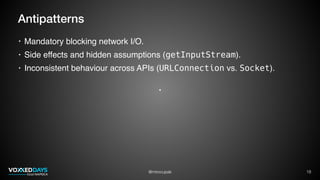The good, the bad, and the ugly of Java API design
- 1. @mirocupak The good, the bad, and the ugly of Java API design Miro Cupak Co-founder & VP Engineering, DNAstack October 31, 2019
- 2. @mirocupak 2 Features • Collections API. • Stack-walking API. • Process API. • HTTP client API.
- 4. @mirocupak 4 Best practices • Take advantage of convenience factory methods for collections. • Immutable collections via of/ofEntries and copies via copyOf. • Less verbose, no static initializer blocks. • Create immutable collections by default, only add mutability when needed. • No need to worry about forgetting references to underlying collections. • Thread-safe and can be shared freely (no need for defensive copies). • Good performance. • Prefer collecting into immutable collections using toUnmodifiableList, toUnmodifiableSet, toUnmodifiableMap. • Use toArray to convert collections to arrays.
- 5. @mirocupak 5 Antipatterns • Obtaining collections through other data structures (Arrays.asList, Stream.of). • Pulling in external dependencies only to obtain immutable collections (e.g. Guava and its Immutable*). • Instance-initializer construct in an anonymous inner class to instantiate collections. • Performance over clean APIs ([List, Set, Map].of).
- 6. @mirocupak 6 Patterns • Static factory methods to create objects (of/ofEntries/copyOf). • Name concisely (convention: of). • Concrete classes not as part of the public API with static methods on interfaces returning instances (pattern for implementation flexibility). • Static import when readability not jeopardized (java.util.Map.entry). • Tuple wrapper objects and convenience methods to generate them when multiple varargs needed (Map.ofEntries). • Converting between types via copyOf. • Constructor reference as a generating function (array in a toArray call). • Immutability by default (collections with copies and collectors).
- 8. @mirocupak 8 Best practices • Take advantage of the Stream API to lazily access only certain elements. • Be aware of StackWalker.Option. • Don’t resolve classes manually. • Use to show hidden and reflection frames.
- 9. @mirocupak 9 Antipatterns • Using [Thread, Throwable].getStackTrace() to traverse selected frames of the execution stack. • Treating execution stack as text. • Using strings to represent Class instances. • Accessing things eagerly when only parts of them are needed. • Surprising hidden method behaviour (omitting elements of the stack for performance).
- 10. @mirocupak 10 Patterns • Collections over arrays. • Leveraging Stream API in API design. • Choose suitable represetations (don’t model everything as strings). • Good performance through lazy access via streams. • Methods accepting functions on streams as parameters to maintain consistent state and control (walk()). • Obtaining configured instances via static factory methods parameterized with enums (getInstance()). • Work with a security manager (secure access to Class objects). • Permission checks when constructing instead of using an object.
- 12. @mirocupak 12 Best practices • ProcessHandle is a clean way of obtaining information about processes. • Take advantage of convenience methods: pid, info, command… • Trigger actions on process termination via onExit. • Connect ProcessBuilder with ProcessHandle via toHandle.
- 13. @mirocupak 13 Antipatterns • Accessing process information via MXBeans or OS utilities. • Pulling in external libraries for simple process management (e.g. Apache Commons Exec). • Incomplete APIs - providing functionality to start hard-to-manage resources without providing the functionality to obtain information about them. • APIs leading the clients to use non-portable constructs.
- 14. @mirocupak 14 Patterns • Providing convenience methods for commonly used functionality. • Compact fluent API to access nested information. • Nested public interfaces to group and organize (ProcessHandle.Info). • Using convenient static factory methods to obtain instances (ProcessHandle.[current, of, allProcesses]). • Returning streams instead of collections to streamline lazy processing of many elements (allProcesses, children, descendants…). • Returning CompletableFuture instances in asynchronous APIs (onExit). • Providing adapters via to* methods (toHandle).
- 16. @mirocupak 16 Best practices • Clear organization: HttpClient, HttpRequest, HttpResponse. • HttpURLConnection is not pleasant to use. • The new client API is versatile, flexible and clean. • Prefer functionality in the JDK to external libraries.
- 17. @mirocupak 17 Antipatterns • Using HttpURLConnection directly. • Inconsistent capitalization (HttpURLConnection). • Overly abstract and general APIs (URLConnection). • Unclear conceptual API model (URL). • Type casting needed to obtain the right instance (openConnection). • Using strings where methods or enums would be more practical (setRequestMethod(“GET”)). • Requiring the client to use I/O boilerplate (BufferedReader/ InputStreamReader/InputStream…).
- 18. @mirocupak 18 Antipatterns • Mandatory blocking network I/O. • Side effects and hidden assumptions (getInputStream). • Inconsistent behaviour across APIs (URLConnection vs. Socket).
- 19. @mirocupak 19 Patterns • Clear separation of concepts at the class level (HttpClient, HttpRequest, HttpResponse). • Builder. • Asynchronous via CompletableFuture. • Clear and consistent naming. • Convenience methods to access commonly used features (statusCode, body).




![@mirocupak 5
Antipatterns
• Obtaining collections through other data structures (Arrays.asList,
Stream.of).
• Pulling in external dependencies only to obtain immutable collections (e.g.
Guava and its Immutable*).
• Instance-initializer construct in an anonymous inner class to instantiate
collections.
• Performance over clean APIs ([List, Set, Map].of).](https://image.slidesharecdn.com/good-bad-ugly-java-api-design-191119171958/85/The-good-the-bad-and-the-ugly-of-Java-API-design-5-320.jpg)



![@mirocupak 9
Antipatterns
• Using [Thread, Throwable].getStackTrace() to traverse selected
frames of the execution stack.
• Treating execution stack as text.
• Using strings to represent Class instances.
• Accessing things eagerly when only parts of them are needed.
• Surprising hidden method behaviour (omitting elements of the stack for
performance).](https://image.slidesharecdn.com/good-bad-ugly-java-api-design-191119171958/85/The-good-the-bad-and-the-ugly-of-Java-API-design-9-320.jpg)




![@mirocupak 14
Patterns
• Providing convenience methods for commonly used functionality.
• Compact fluent API to access nested information.
• Nested public interfaces to group and organize (ProcessHandle.Info).
• Using convenient static factory methods to obtain instances
(ProcessHandle.[current, of, allProcesses]).
• Returning streams instead of collections to streamline lazy processing of
many elements (allProcesses, children, descendants…).
• Returning CompletableFuture instances in asynchronous APIs
(onExit).
• Providing adapters via to* methods (toHandle).](https://image.slidesharecdn.com/good-bad-ugly-java-api-design-191119171958/85/The-good-the-bad-and-the-ugly-of-Java-API-design-14-320.jpg)





